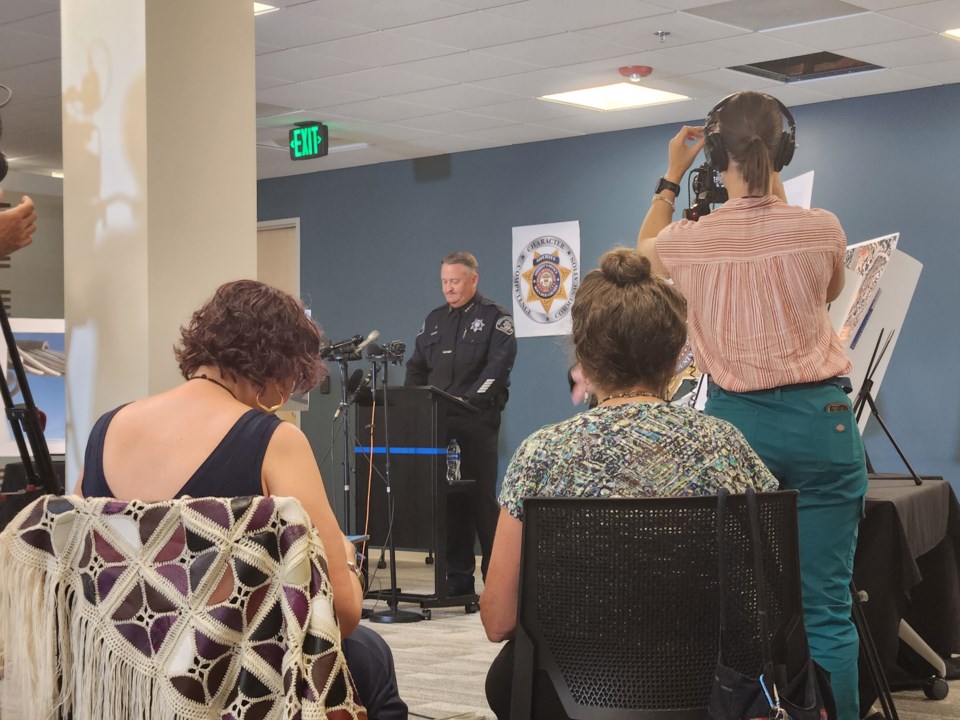On Thursday, the Boulder County Sheriff’s Office and Boulder County District Attorney’s Office revealed the results of their 18-month investigation into the causes of the Marshall fire.
The investigation determined that there were two ignition points of the Dec. 31, 2021 fire that went on to destroy over 1,000 homes, kill two people and become the most destructive fire in Colorado history. The district attorney’s office also found that there was insufficient or no evidence to pursue any criminal charges.
Boulder County Sheriff Curtis Johnson and District Attorney Michael Dougherty explained the investigation at a press conference Thursday in Boulder. The two offices worked closely throughout the investigation and agree with the conclusions shared in the summary report.
Johnson outlined the unique conditions leading up to the Marshall fire, from the unusually warm and wet spring of 2021 to the extreme dryness from June to December of that year. This coupled with an extreme wind event with frequent gusts close to 100 mph in the late morning and early afternoon.
The Marshall fire consisted of two fires, according to the investigation, one originating at 5325 Eldorado Springs Drive, the Twelve Tribes community, and one at the Marshall Mesa Trailhead just southeast of Highway 93 and Eldorado Springs Drive. The Marshall Fire Investigation Summary and Review provides a broad overlook of the investigation and the conclusions reached.
“Burn patterns, video footage and satellite imagery show that these two fires eventually merged, though investigators did not determine the precise time or place at which that occurred,” the report said.
The sheriff’s office provided several supplementary documents diving further into the many aspects of the investigation on their website.
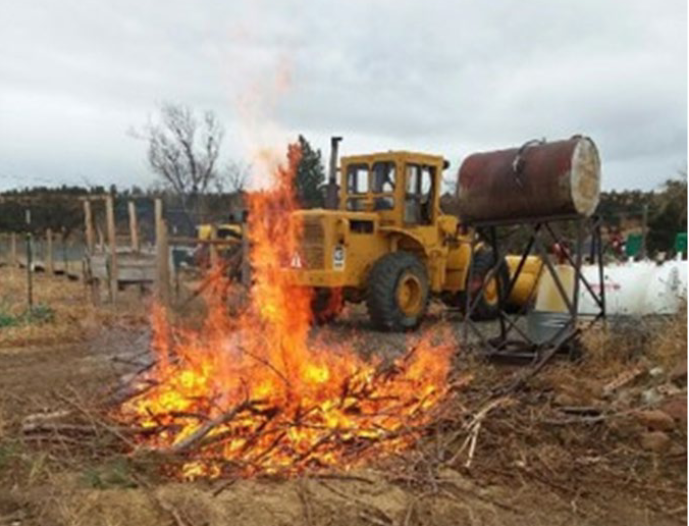
Twelve Tribes ignition
The Boulder County investigation concluded that the fire that started on the Twelve Tribes property was initially lit six days prior, on Dec. 24. Just before noon that day, the Boulder County Communications Center received a call from a community member concerned with the size of a fire intentionally lit on the property.
Residents told the responding firefighters, sheriff deputy and park ranger that they started the burn to dispose of various materials. The day was cool, rainy and overcast and the burn had water nearby. Once the fire burned out the residents planned to bury the fire with dirt.
“When interviewed, the firefighters … reported being unconcerned with the fire,” the report said. “Though they observed lumber and larger pieces of wood in the fire, they believed the residents’ plan to let the fire burn out and cover the area with dirt was responsible.”
The resident who was managing the burn later told detectives he allowed the fire to burn until about 5 p.m., when it had reduced to coals. He covered the coals with dirt but did not add water to extinguish them.
In the following days, none of the roughly 40 residents at the property saw smoke or other indications the fire continued to burn, according to the report.
On Dec. 30, a homeowner on Marshall Drive called 911 to report smoke at the Twelve Tribes property. Mountain View Fire Rescue responded, with firefighters seeing sparks blowing out of a slash pile that was partially covered in dirt along with active flames between a shed and a fence.
“The shed was not yet burning, an observation later confirmed through photographic and video evidence,” the report said, adding that investigators did not discover any electrical service to or from the shed.
It was concluded that the extraordinarily high winds uncovered the buried Dec. 24 fire and exposed still-smoldering embers to fresh oxygen and blew them across the property.
Researchers at the Missoula Fire Science Laboratory told investigators that smoldering combustion may exist for days or weeks after the visible flame and smoke production has ceased — and can exist for weeks or months under the right conditions.
Investigators found no evidence that residents at the Twelve Tribes property started any other active fires after Dec. 24 leading up to the Marshall fire. Every adult resident was interviewed, as were the child residents by specialized child forensic examiners.
The Twelve Tribes organization did not respond to a request for comment.
Was this a crime?
Dougherty explained that a person may be held criminally liable when the evidence proves beyond a reasonable doubt every element of an offense as defined by Colorado statute. For arson, proof is required that a suspect acted “knowingly” or “recklessly.”
Prosecutors may initiate criminal charges only if they are supported by probable cause and there is sufficient evidence to support a conviction beyond a reasonable doubt, Dougherty said. There was not enough evidence, in the opinion of the office, to justify pursuing criminal charges.
“Here, there is no evidence that the residents who started the Dec. 24, 2021 fire were aware that it was practically certain that fire would smolder for several days and reignite a week later when uncovered by extreme downslope winds,” the report said. “Nor is there evidence that the residents disregarded a substantial and unjustifiable risk that this would occur.”
Neither state nor local regulations prohibited the Dec. 24, 2021 fire, the report added. Johnson emphasized that hundreds of controlled burns are lit on Boulder County properties throughout the year, though they are subject to certain limitations and permitting requirements.
Persons intending to open burn “may” apply for a permit, per Colorado regulations, but this is interpreted as permissive, not mandatory, according to the report. Therefore, the residents were not required to obtain a permit before initiating the burn.
Considering the weather, use of dirt and presence of water, along with the input of firefighters, the report found that the fire did not constitute reckless conduct or violate any other law.
Since the Marshall fire, Boulder County has revised its ordinance to require permits for slash burns and published new guidance for residents who may wish to conduct a burn. Specifically, it now instructs residents to use water to extinguish fires.
“I’m not an active camper or fire builder, but I’ll tell you I was always taught to put fires out with water and then bury them and check to make sure the coals are not warm to the touch before you believe that fire’s fully extinguished,” Johnson said.
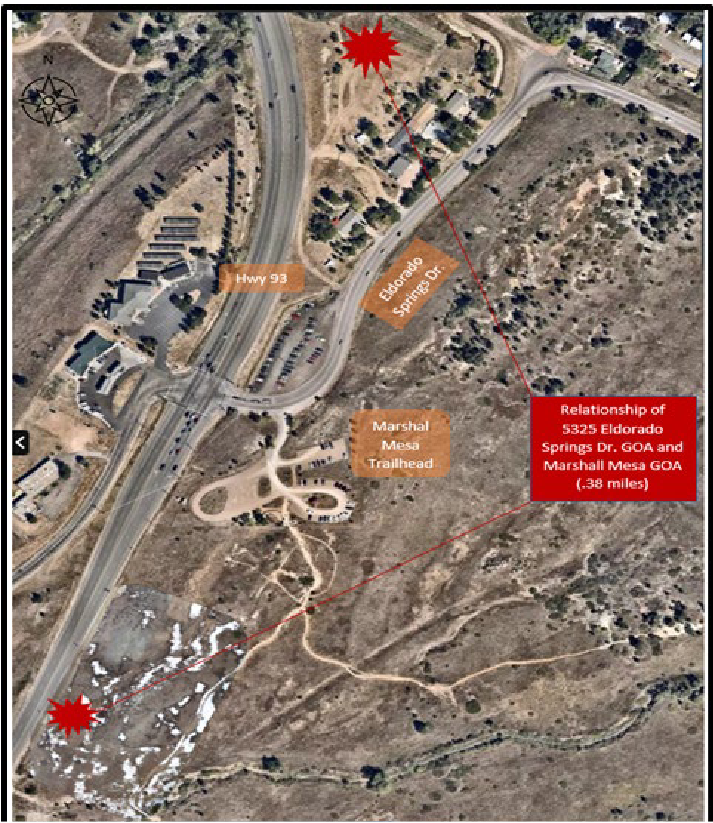
Trailhead ignition
The fire that started at the Marshall Mesa trailhead, referred to as the Trailhead fire in the report, is a bit more complex. The answer is not as definitive as to the ignition source, but investigators said the most probable cause was hot particles discharged from Xcel Energy power lines.
Xcel Energy, in an emailed comment to the Longmont Leader, disputes this conclusion.
The Boulder County report said that initial investigation focused on the possibility the fire was caused by an ember from the Eldorado Springs fire. Inspections, fire indicators, prevailing winds and the distance from the other fire led investigators to conclude that the trailhead ignition was almost certainly not caused by an ember from the Eldorado Springs fire.
The distance between the two ignition points was about 2,000 feet, with the Trailhead fire’s ignition point situated southwest of the Eldorado Springs fire. Winds that day were predominantly west-to-east.
“Though topography and other factors can cause winds to temporarily swirl and shift direction, it is highly improbable that an ember could have traveled over 2,000 feet against the prevailing winds and retained enough energy to ignite a second fire,” the report said.
Investigators then looked into nearby power lines, as initial media reports suggested that a downed line might have been responsible for igniting the Marshall fire. Investigators determined that those reports concerned a communications line at Highway 93 and Eldorado Springs Drive, which agents and consultants concluded did not carry sufficient electrical current to start a fire.
While examining the downed communications line, U.S. Forest Service special agents found what appeared to be damage to a transmission line and transformer on the Xcel Energy electrical distribution system, leading to a close inspection of the powerlines running south along Highway 93 past the Marshall Mesa trailhead. As of Jan. 5, 2022, investigators had not located any additional damage to the area’s powerlines.
During the following days, the sheriff’s office collected images from a motion-activated trail camera at the Marshall Mesa trailhead. In the background, a section of the Xcel Energy distribution system is visible.
A series of photographs show that between 10:30-11:10 a.m., one of the three powerlines became unmoored and sagged low enough to contact a support brace, the report said. Subsequent photos showed smoke and flames in an area near the base of the pole.
Individuals who visited the trailhead during and after the fire provided photos and videos that confirmed that the powerline detached from its insulator before the Trailhead fire ignited, the report said.
Investigators returned to the area Jan. 14, 2022 and found discarded aluminum lashing wires. They also located two specific areas where the fire may have ignited — one 80 feet from the powerline and one 110 feet away.
The sheriff’s office then retained Paul Way, an electrical engineer and wildland fire expert from Jensen Hughes, a consulting firm. He examined the powerline in person and observed significant evidence of electrical arcing.
Xcel Energy employees, at investigators’ request, transported the items to a laboratory for analysis. The consulting firm determined that the amount of conductor missing from the wire could have retained enough energy to ignite fuels even after traveling approximately 110 feet.
Investigators worked with Xcel Energy representatives for nearly a year to obtain data from the electrical transmission system, according to the report.
“Analysis of that data tended to confirm investigators’ conclusions that the power lines were the most probable cause of the Trailhead Fire,” the report said. “Specifically, data showed that the circuit with the disconnected line opened and closed several times on December 30, 2021. Circuits open and close in this manner when there is a fault. Though none of the events recorded in Xcel Energy’s data occurred at precisely the estimated time of ignition, the opening and closing indicates the system did sustain faults or interruptions on December 30, 2021.”
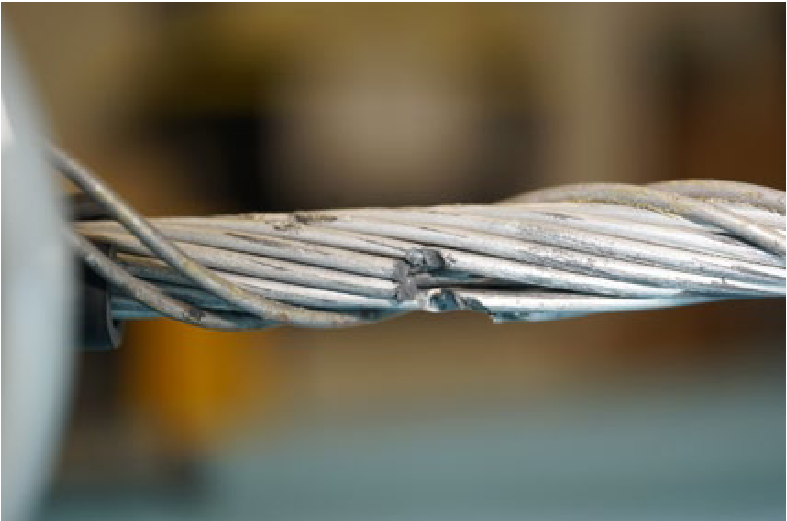
Was this a crime?
The report said investigators found no evidence of criminally negligent or reckless system design or maintenance on the part of Xcel. It appears the extraordinarily high winds cause the powerline to disconnect and contact other lines, discharging hot particles into a receptive fuel bed.
Xcel emphasized the company’s belief that the power system was well-maintained.
“We have reviewed our maintenance records and believe the system was properly maintained,” Xcel said in a statement. “We operate and maintain our electric system consistent with leading energy service practices …”
However, investigators did not initially find the unmoored powerline. According to the report, this is because Xcel Energy reattached the line on Jan. 2, 2022, possibly in violation of a “do not repair” order the company issued on Dec. 31, 2021.
Investigators looked into whether this was intended to interfere with the investigation, but the report said that evidence indicated that Xcel repaired the disconnected line “solely to restore power to customers.”
“Given the temperatures and snowy conditions, investigators learned that Xcel Energy had been urged to restore power as quickly as possible,” the report said.
On Dec. 31, the Boulder County Office of Emergency Management tweeted that Xcel Energy found no downed power lines in the ignition area. Given the discovery of the disconnected powerline, investigators looked into this discrepancy.
The report determined that “downed power line” refers to a line that became detached from its pole and contacted the ground. The line involved in the Trailhead fire is considered a “floater” as a line detached from its pole but still suspended in the air.
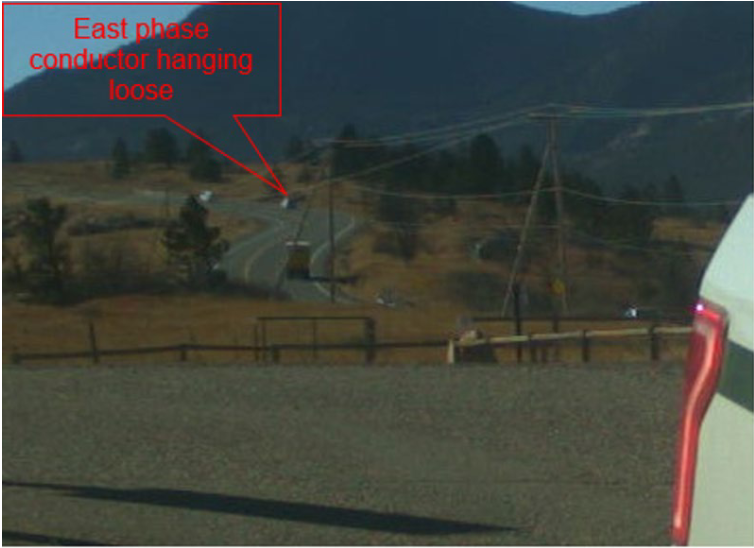
Coal seams
The report noted that while the powerline is the most probable cause of the Trailhead fire, investigators cannot rule out the possibility that it could have been ignited by an underground coal fire in the same area.
A coal seam running under the Marshall Mesa trailhead is actively burning, and lit a grass fire in 2005. Abatement work was conducted after that fire and again 10 years later.
As part of the Marshall fire investigation, a private consulting company sampled ground temperatures, gas discharge and conducted thermal imaging on Jan. 7, 2022, and Jan. 14, 2022. The conditions were found to be inconsistent with conditions required to ignite a surface fire.
On Feb. 22, thermocouples were installed to monitor underground temperatures. Subsurface temperature data was collected following high-wind events in February and March 2022.
“Though these wind events did not produce gusts equal to those that occurred on Dec. 30, they also did not result in any demonstrable increase in subsurface temperatures,” the report said. “This tends to confirm the experts’ conclusion that the underground seam was not exposed to outside oxygen even in the high wind conditions during the Marshall Fire.”
What now?
The district attorney’s decision to not pursue criminal charges does not limit civil action, where less stringent laws, rules and levels of proof apply.
When and where the two ignitions merged was not determined by this investigation. The report maintains that questions of the merge are not relevant, as the cause and origin analysis focuses on only how the fires started and whether criminal charges could be filed.
“Though the fire devastated thousands of people, there is insufficient evidence that a crime was committed,” the report said. “If new information comes to light through other investigations or civil litigation, the Sheriff’s Office and District Attorney’s Office will review it.”
Johnson, who lost his home in the Marshall fire, spoke to his personal feelings about the outcome of no criminal charges. The sheriff said he’s focusing on moving forward.
“I know that ultimately, sometimes, really bad things happen. I was caught up in that,” he said. “My home was lost, but I’m moving forward because for me it’s very important to reclaim my life after the fire. The only way that I feel I can do that is to rebuild my home, plant my flag and get back in my neighborhood.”
Mental and emotional health partners in the community will be providing in-person events in the community through the coming weeks. Full details are available on the county’s website.
